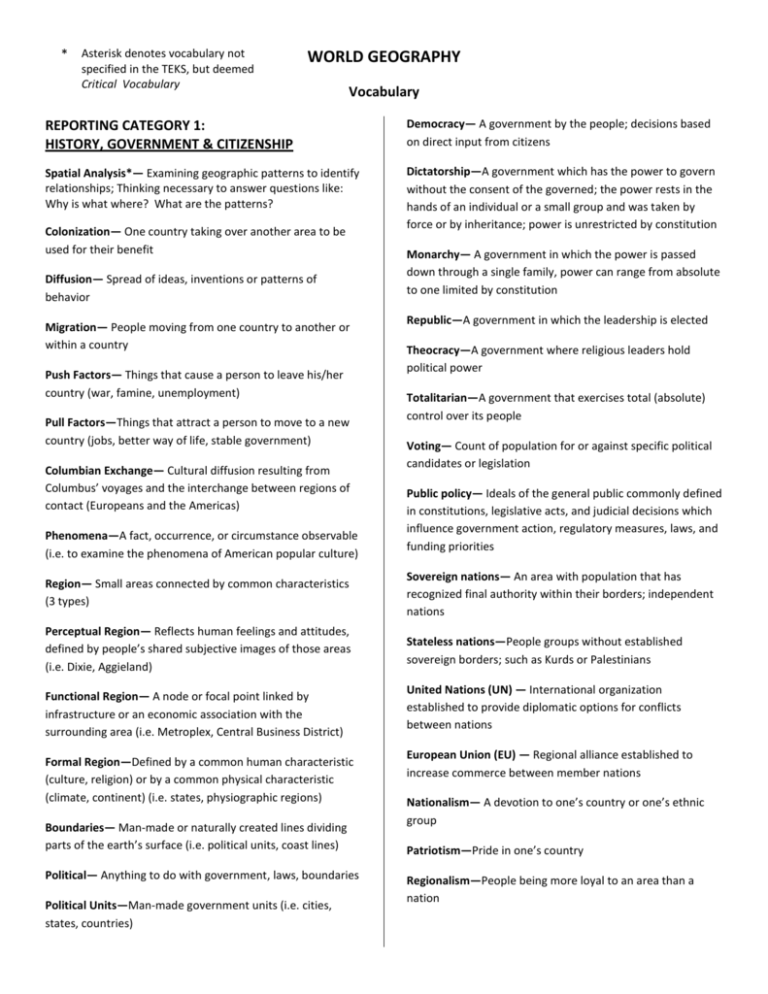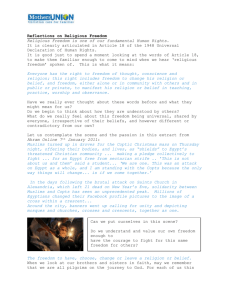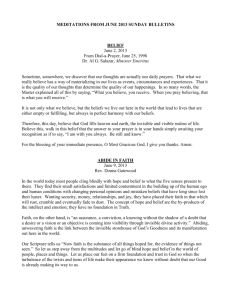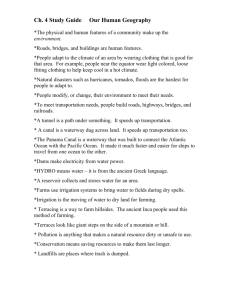World Geography Vocabulary Terms
advertisement

* Asterisk denotes vocabulary not specified in the TEKS, but deemed Critical Vocabulary WORLD GEOGRAPHY Vocabulary REPORTING CATEGORY 1: HISTORY, GOVERNMENT & CITIZENSHIP Democracy— A government by the people; decisions based on direct input from citizens Spatial Analysis*— Examining geographic patterns to identify relationships; Thinking necessary to answer questions like: Why is what where? What are the patterns? Dictatorship—A government which has the power to govern without the consent of the governed; the power rests in the hands of an individual or a small group and was taken by force or by inheritance; power is unrestricted by constitution Colonization— One country taking over another area to be used for their benefit Diffusion— Spread of ideas, inventions or patterns of behavior Migration— People moving from one country to another or within a country Push Factors— Things that cause a person to leave his/her country (war, famine, unemployment) Pull Factors—Things that attract a person to move to a new country (jobs, better way of life, stable government) Columbian Exchange— Cultural diffusion resulting from Columbus’ voyages and the interchange between regions of contact (Europeans and the Americas) Phenomena—A fact, occurrence, or circumstance observable (i.e. to examine the phenomena of American popular culture) Monarchy— A government in which the power is passed down through a single family, power can range from absolute to one limited by constitution Republic—A government in which the leadership is elected Theocracy—A government where religious leaders hold political power Totalitarian—A government that exercises total (absolute) control over its people Voting— Count of population for or against specific political candidates or legislation Public policy— Ideals of the general public commonly defined in constitutions, legislative acts, and judicial decisions which influence government action, regulatory measures, laws, and funding priorities Region— Small areas connected by common characteristics (3 types) Sovereign nations— An area with population that has recognized final authority within their borders; independent nations Perceptual Region— Reflects human feelings and attitudes, defined by people’s shared subjective images of those areas (i.e. Dixie, Aggieland) Stateless nations—People groups without established sovereign borders; such as Kurds or Palestinians Functional Region— A node or focal point linked by infrastructure or an economic association with the surrounding area (i.e. Metroplex, Central Business District) Formal Region—Defined by a common human characteristic (culture, religion) or by a common physical characteristic (climate, continent) (i.e. states, physiographic regions) Boundaries— Man-made or naturally created lines dividing parts of the earth’s surface (i.e. political units, coast lines) Political— Anything to do with government, laws, boundaries Political Units—Man-made government units (i.e. cities, states, countries) United Nations (UN) — International organization established to provide diplomatic options for conflicts between nations European Union (EU) — Regional alliance established to increase commerce between member nations Nationalism— A devotion to one’s country or one’s ethnic group Patriotism—Pride in one’s country Regionalism—People being more loyal to an area than a nation REPORTING CATEGORY 2: GEOGRAPHY Physical Patterns/Processes Lithosphere— Earth’s crust and solid upper mantle, broken into tectonic plates Plate tectonic theory— Idea that the lithosphere is made up of moving tectonic plates Ring of Fire—Area around the Pacific Ocean known for frequent earthquakes and volcanoes Tsunami—Large displaced walls of water created by earthquakes under or near oceans Barriers—Obstacles, physical or human blocks to movement Assists*—Factors which support unrestricted movement Atmosphere— The air, layers of gases surrounding Earth Climate—Average weather conditions of a place over a long period of time Latitude—Coordinate measuring north and south of the equator (0 degrees); primary element of climate and a strong influence on settlement Water cycle (hydrologic cycle) — Movement of water between evaporation, condensation, precipitation, and transpiration Precipitation—Water that moves from the atmosphere to the Earth’s surface (rain, snow, hail, etc. . .) Glacier— Large sheets of slow moving ice Biosphere— All life forms on Earth Physiographic region*— An area that shares common physical features Vegetation—Type of plants an area supports Biomes— Different regions which support various kinds of life (i.e. forest, grassland, desert, and tundra) Erosion—Processes by which rock, sand, and soil are broken down and carried away (i.e. weathering, glaciation) Weathering—Wearing away of Earth’s surface caused by wind, water, ice, or chemicals Soil-building—Process where the breakdown of rocks and organic materials creates arable (farmable) land Human Patterns/ Processes Elevation—Measurement above or below sea level Human Environmental Interaction (HEI) — How humans adapt, change, and modify their environment Wind Systems—Global wind patterns; such as the trade winds and doldrums Carrying Capacity*— The amount of life a piece of land can support Monsoons*—seasonal prevailing wind in the region of the Indian subcontinent and Southeast Asia (summer wet/winter dry) Demographics—Profile of human population at a given time, with data broken out into categories Per capita— Per person, average for each person Ocean Currents—Global patterns created from the movement of the oceans; such as the Gulf Stream El Niño—Unusual warming of ocean temperatures in the Equatorial Pacific Ocean which shifts normal weather patterns La Niña*—Unusual cooling of ocean temperatures in the Equatorial Pacific Continentality—Position from the influence of the sea, especially regarding climate Weather—Conditions in the atmosphere closest to Earth Hydrosphere—Earth’s water Gross domestic product (GDP) —Measure of a nation’s income; value of all the goods and services a nation produces within their country Life expectancy—Average age a population lives to; mortality rate Literacy—% of population that can read and write competently Infant mortality rate—Number of infants who die for every thousand births REPORTING CATEGORY 2: (Continued) GEOGRAPHY Human Development Index (HDI) —Formula used to categorize the development level of nations (less developed, newly industrialized, and more developed) Standard of living— Quality of life based on some measure such as number of cars, accessibility of medical care, education, etc. . Population Pyramids—Graph showing % of males and females by age group for a population Globalization— Spreading of a phenomenon or culture traits worldwide Trade networks—Major patterns of exchange in specific regions Connectivity— Interrelationships, frequency of contact with others such as isolationism (low connectivity) or international involvement (high connectivity) Chokepoint*—A narrow, strategically significant area where trade could be easily blocked or controlled Pandemic—World wide spread of disease over time Sustainable development—Using resources to meet present needs while protecting the resources and environment for the future Renewable resources—Resources which are replenished over time Non-renewable resources—Resources which can only be used once or are not easily replenished Settlement—Where people live Urban— City Rural—Country Urbanization—Mass movement of people from farms to cities; growth of city into surrounding countryside Megalopolis*—Continuous urban region including several cities Agriculture—Farming Deforestation— The clearing of forest covering Desertification— The process of changing into desert, lack of rainfall causes desert conditions to expand/grow Industrialization—Development of a system which supports machine production of goods Irrigation—Man-made system to provide water to less arid areas REPORTING CATEGORY 3: CULTURE REPORTING CATEGORY 3: (Continued) CULTURE Culture—Way of life common to a group of people Ethnicity*—a social group that shares a common national or cultural heritage Multiculturalism—blending of several different cultures Culture elements/ traits—Language, religion/belief, institutions (education), customs, technologies, land use Institutions—Complex social organizations such as governments, economies, and education systems Customs—Common practices followed by people of a particular group or region Land use— Various ways humans use the land such as agricultural, industrial, residential, or recreational Social— Anything to do with people, culture, society Culture Hearth*—Central location where ideas, inventions and /or culture traits originate Animism—Polytheistic faith based on the belief that many things in nature have their own spirit Hinduism—Faith originating in India based on the belief that a person’s karma (behavior in life) impacts their reincarnation (rebirth) in their next life; holy text: Upanishads and the Bhagavad-Gita Buddhism—Faith originating in Nepal, based on the teachings of Siddhartha Gautama, including belief that following the Eight-Fold Path and the Four Noble Truths will lead to Nirvana (absolute peace) Judaism—Monotheistic faith originating in Israel, based on the teaching of Abraham and Moses, including the Ten Commandments; holy text: Torah (First 5 books of the Old Testament in the Bible) Christianity—Monotheistic faith originating in Israel, based on the teaching of Abraham, Moses, and Jesus Christ, including a belief that Jesus is the son of God and died for human salvation; holy text: the Bible (Old and New Testament) Islam—Monotheistic faith originating in Saudi Arabia, based on the teaching of Mohammad, including the Five Pillars; holy text: Qu’ran Sikhism— Monotheistic faith originating in the Punjab region of India, based on the teachings of Guru Nanak Dev Ji and Guru Gobind Singh Ji, includes valuing equality Caste*—hereditary social group ranked by degree of spiritual purity along with occupation and/or economic position Under- represented populations—People groups with limited political and economic power Convergence—Occurs when a group accepts or adopts elements of culture from a different group or region Divergence—Occurs when a group isolates elements of culture due to physical or human characteristics Genocide— The systematic killing of an entire race or ethnic group of people (i.e. Hutus in Africa, Jews during Holocaust) Terrorism—Acts of violence designed to promote a specific ideology or agenda by creating panic among an enemy population Economic— Anything to do with money, jobs, commerce Communist—Command system, government owns the means of production, economic decisions are made by central government, and government provides extensive social programs for population Scarcity—Limited quantities of resources to meet unlimited wants Nation-State*— An independent nation of people having a common culture and identity Traditional Economies—Farming, hunting, bartering Regulations—Government rules and restrictions affecting business and development REPORTING CATEGORY 4: ECONOMIC, SCIENCE & TECHNOLOGY Primary economic activities—Direct use of natural/raw resources such as mining or agriculture Secondary economic activities—Use of natural/raw resources to make consumer products, such as manufacturing Tertiary economic activities—People-based activities, such as service jobs like waitresses or retail sales Quaternary economic activities— Highly skilled professions which deal with movement and processing information such as specialized researchers Economic spectrum—Scale describing the amount of government and/or private influences on the distribution and use of factors of production Subsistence agriculture—Farming to feed immediate family only Commercial agriculture—Large scale farming done for profit Commerce*— The buying and selling of goods or services Manufacturing—Mass production of goods using machines Free trade zones— A region where a group of countries has agreed to reduce or eliminate trade barriers Infrastructure—Public systems that assist commerce; such as port or power grid Transportation—Methods used to move people and goods and their supporting systems (i.e. railroads, airlines, highway system) Break of Bulk*—Place where trade goods move from one form of transportation to another Technology—Application of tools or science to make life easier Innovation—New way of doing something; inventions Air conditioning—Technology which modifies environment by cooling air in a specific space Desalinization—Technology to remove salt from ocean water Outsourcing— When one company hires another to perform a specific function, often using international sources to reduce labor costs Goods—Agricultural and manufactured products Services—Actions or activities one person performs for another Cottage industry—Home or village-based production Commercial industry—Factory-based production Free enterprise—Market system, capitalism, individuals own means of production, economic decisions are made based on market forces (supply, demand, profit margin), individuals support limited social programs through taxes or charity donations Socialist— Mixed, combination of government and private ownership of the means of production, government provides a number of social programs funded by higher taxes, government and individuals make economic decisions Global Positioning System (GPS) —Technology utilizing satellites in earth orbit to calculate and display accurate location, speed, and time information to the user Geographic Information Systems (GIS) —Spatial information systems which map database information; such as NAFTA or EU





